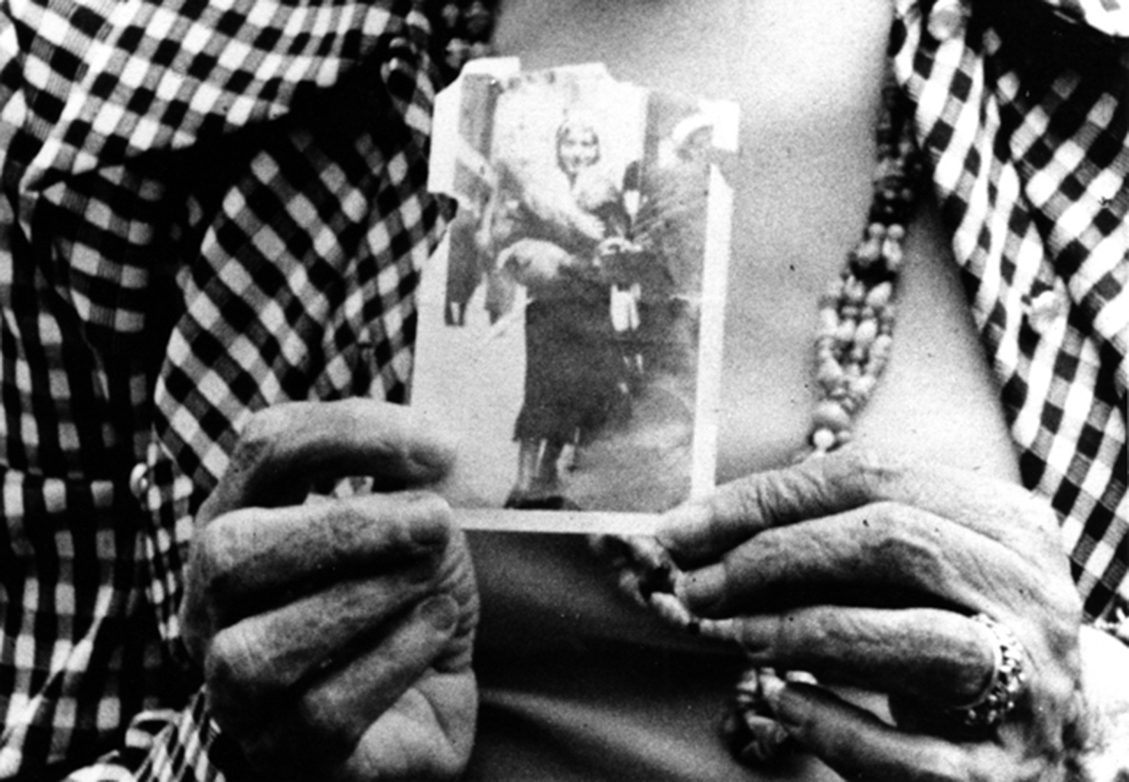
By Tess Takahashi
I came to Canyon Cinema with the project of researching little-seen experimental work by women made on 16mm between the 1960s and the 1980s. Having long wondered how the history of the avant-garde cinema might shift if a different group of filmmakers had been taken up by critics and scholars as the avant-garde “canon” was beginning to form, I meandered—with expert guidance and support from Canyon’s lovely staff and volunteers—through Canyon’s collection searching for overlooked gems by women, queer filmmakers, and people of color. This short essay surveys the work of six women filmmakers featured in the Canyon Cinema 50 touring programs. While experimental film enthusiasts likely know many of these names, their individual oeuvres are full of surprising works that we’ve all been missing out on.
Sara Kathryn Arledge’s stunning—and diverse—body of films span from the early 1940s to the 1980s. What is a Man? (1958), featured in the Canyon Cinema 50 Touring Program 2, is a tour de force said to have been made after the artist spent some time in a mental asylum. The film is structured as a series of absurdist vignettes between a woman and a car salesman, her psychiatrist, and her lover, in which double entendres produce a farcical critique of gender relations. Sharing an affinity with Owen Land’s On the Marriage Broker’s Joke… (1979), What is a Man? and Arledge’s What Do Two Rights Make? (1983) employ short skits and biting word play to comment on cultural mores. Arledge’s body of work also includes formalist and painterly abstraction, as in Introspection (1941), a beautiful, prismatic film featuring three male dancers, whose solarized forms are layered and manipulated through optical printing (the result gives Maya Deren a run for her money). Arledge also made a number of abstract, jewel-like films based on her translucent painted color slides, many of which are held by the Berkeley Art Museum and Pacific Film Archive. These include Tender Images (1978) and Interior Garden (1978), films that evoke Brakhage’s later hand-painted works.
Betzy Bromberg’s Ciao Bella, or Fuck Me Dead (1978) is a classic, bad-ass girl motorcycle extravaganza included in Canyon 50 Touring Program 1. It’s also perhaps her most screened film, but Bromberg’s other works at Canyon are a revelation. Soothing the Bruise (1980) is an associative weave of bright colors, beautiful girls, and everyday scenes juxtaposed with an allusive soundtrack (and striking final titles) that evokes the political, cultural, environmental, and gendered implications of ordinary conversation. Marasmus (1981), Bromberg’s collaboration with Laura Ewig is likewise beautifully shot in sumptuous color and layered with masterful optical printing. Described by Janice Crystal Lipzin as “full of seductive glamour,” Marasmus overlays a cis woman with a trans woman in full make-up, scarves, and glittery outfits pictured in a mirrored room, in the desert, and in the mountains. The film’s complex, essayistic amalgam of sound and voice, the poetic and political, is never didactic or heavy-handed. Canyon has a ton of Bromberg’s other, under-screened 16mm titles as well, including Petite Mal (1977), Az Iz (1983), The Body Politic (1988), Divinity Gratis (1996), and A Darkness Swallowed (2005).
Chicago-based artist Jean Sousa’s films are formally rigorous, sensually present, and always inventive in their explorations of different cinematic properties. Swish (1982), in Canyon 50 Touring Program 1, is a silent investigation of the medium’s relationship to motion, offering occasional, swishing glimpses of a young Sousa as she dances with her moving camera, her face close to the camera’s open shutter. Ellen on the Rope (1978) features multiple takes of the eponymous Ellen swinging back and forth across the length of a nearly empty loft apartment. The two artists, filmmaker and performer, work together to produce “a strobing rhythm by crossing the camera’s shutter speed with the rate of the rope traversing its frame,” in the words of B. Ruby Rich. Sousa’s The Circus (1977) is a colourful and elaborate optically printed film that edges its depictions of circus performers closer and closer to the bright abstraction of moving shapes and colors. Also check out Sousa’s Summer Medley (1977), What Am I Doing Here (1978), Spent Moments (1984), and Today is Sunday (1987). Her mix of structural and somatic investigation gives structural film a completely different feel.
Similarly, JoAnn Elam’s Lie Back and Enjoy It (1982), featured in Canyon 50 Touring Program 3 and Digital Program 1, is a knockout that mixes the structural, the critical, and the sensuous. I imagined a more didactic piece, which, as Claudia Gorbman writes, “examines the politics of filmic representation of women under patriarchy.” What I found instead was a fascinating combination of a visually pleasurable image, as the film’s close-up of a woman’s face is optically printed and transformed over the course of the film, juxtaposed against audio of a conversation between a male filmmaker and his intended female subject as she jokingly shows him that his simple desire “to make art” and to “tell the truth” is anything but simple. This is a sharp, funny, aesthetically compelling film that should have been an instant classic. It not only has the power to surprise veterans of the avant-garde film scene but also could be valuable in an intro film course. Elam’s other film in Canyon’s collection, Rape (1975), an explicitly feminist documentary that captures a group of women as they speak frankly about their personal experiences with rape, is very different in tone, and would be a particularly provocative historical document to screen in the #MeToo era. Check out Chicago Filmmakers for Elam’s other titles.
Greta Snider might be the punk inheritor of Robert Frank and Alfred Leslie’s Pull My Daisy (1959). I was most familiar with works like Quarry Movie (1999), her environmentally-minded collaboration with a number of other filmmakers to “document a place – not only its image as lensed, but its weather, its soil, and its toxins,” in Snider’s words. However, I was bowled over by the vigor and exuberance of her earlier work: their black-and-white images can be rough and grainy, but their structure is both formally precise and playfully engaging. Snider’s Portland (1996), which is part of Canyon 50 Touring Program 1, was one such revelation, with its charismatic characters (Snider’s friends), interwoven narrative, smart reflexive points, and youthful joie de vivre. It would be great for teaching an intro film class about narrative construction. Similarly, Hard Core Home Movie (1989) feels like a commentary on the semiotics of authenticity with its carefully constructed, quasi-anthropological assortment of punk kids, middle-aged tourists, and passers-by espousing their thoughts about what it means to be “hard core.” Canyon has a trove of Snider’s films on 16mm, including Futility (1989), Blood Story (1990), Mute (1991), Our Gay Brothers (1993), No Zone (1993), Flight (1996), Urine Man (2000), and The Magic of Radio (2001).
Finally, Cauleen Smith’s Chronicles of a Lying Spirit (by Kelly Gabron) (1992) should take its place alongside works like Trinh T. Minh-ha’s Reassemblage (1982) and Rea Tajiri’s History and Memory (1991). While Smith has made many, many films integrating disparate genres, forms, and technologies, Chronicles of a Lying Spirit (By Kelly Gabron) feels like a real find. It explores questions of race, history, gender, autobiography, documentary, and art-making practice through formal experimentation with layered images and a dense mix of voices. Smith takes the viewer through the same material twice, a journey that results in very different readings, before leading into a revelatory final sequence. This film makes me eager to explore Smith’s larger oeuvre.
So, then, to return to my opening question, what kind of avant-garde canon might we have if we looked more broadly across the body of films being made in that period – and deeper into the work of individual filmmakers? Perhaps not unexpectedly, the work of many women filmmakers between the 1950s through the late 1980s raises questions of film’s identity as a medium as it overlaps with questions of personal, political, gendered, and embodied identity. As in the experimental videos concerning identity politics produced in the 1980s and 1990s, some of this work might have been seen as edging into the realm of documentary despite a characteristically “avant-garde” attention to questions of form and medium. This essay only scratches the surface of Canyon Cinema’s rich holdings, but I hope it suggests some of the joys and revelations that digging beyond the usual suspects can hold for programmers, teachers, and curators. We should remember that canons are porous, contingent, and ever-shifting – produced in part by circumstance, geography, friend groups, and other vagaries of history. Established canons may be full of amazing works, but they ought to be questioned, argued over, and shaken up. In addition to the filmmakers noted above, the programs in the Canyon Cinema 50 Tour include great works by a number of other women filmmakers including Stephanie Barber, Abigail Child, Mariah Garnett, Janie Geiser, Barbara Hammer, Karen Holmes, Julie Murray, Gunvor Nelson, Charlotte Pryce, Emily Richardson, Chick Strand, and Naomi Uman that will shift your sense of the history of avant-garde film.
Tess Takahashi is a Toronto-based scholar, writer, and programmer who focuses on experimental moving image arts. She is currently working on two book projects, Impure Film: Medium Specificity and the North American Avant-Garde (1968-2008), which examines artists’ work with historically new media, and On Magnitude, which considers contemporary artists’ work against the backdrop of Big Data and data visualization. Takahashi has been scholar-in-residence at the Film-Makers’ Co-op in New York City (2015), at Canyon Cinema in San Francisco (2016-17), and the Canadian Filmmakers’ Distribution Center in Toronto (2017-8). She is a member of the experimental media programming collective Ad Hoc and the editorial collective for Camera Obscura: Feminism, Culture, and Media. Takahashi’s writing has been published there as well as in Cinema Journal, the Millennium Film Journal, Animation, MIRAGE, and Cinema Scope.
General & Title Inquiries
Canyon Cinema Foundation
1777 Yosemite Ave Suite #210
San Francisco, CA 94124


